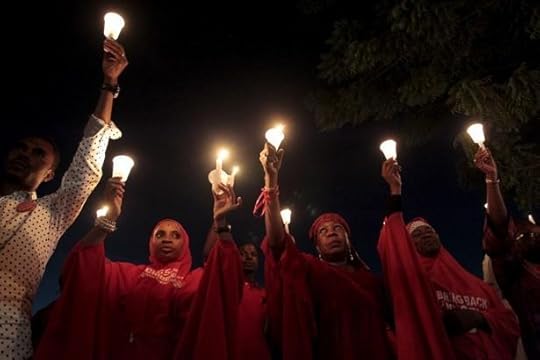Atlantic Monthly Contributors's Blog, page 293
November 19, 2015
The Sublime Darkness of Jessica Jones

When viewers first meet the private investigator Jessica Jones (Krysten Ritter), she’s throwing a client through her front-door window. Things only go downhill from there. Marvel’s newest hero, whose eponymous series debuts on Netflix this Friday, might be its most flawed, but she’s also its most fascinating, and her show marks an evolutionary leap forward for the brand’s expansive collection of movies and TV shows, deftly exploring themes of trauma, abuse, and prejudice. It’s taken too long to get here, but Jessica Jones is exactly what the overwhelmingly male Marvel Universe has been crying out for.
Related Story
Daredevil: A Longform Approach to Comic-Book Television
The show is as marked a sea change as the comic-book title on which it’s based—Alias, created by Brian Michael Bendis and Michael Gaydos in 2001, which was the first “Marvel MAX” book, a work that could depict explicit sex, language, and violence. Jessica Jones is the second Marvel series to air on Netflix after Daredevil, but while that show was dark and violent, its hero was still a traditional do-gooder looking to take down a big bad gangster. From minute one, Jessica Jones operates in shades of grey, offering a complex character who’s haunted by a scarily mundane supervillain, and working through tribulations in sometimes ill-advised ways. It’s different, but it’s one of the best things Marvel Studios has released.
As created by Bendis, the character of Jessica operates as a sort of dark commentary on superhero fandom. She’s a normal high-school student and admirer (from afar) of Peter Parker’s until an industrial accident gives her super-strength and the ability to fly. She tries to become a costumed do-gooder, but an encounter with a powerful villain, Zebediah Killgrave, puts an end to that. So she starts a detective agency, trying to overcome both her experience with Killgrave and her ineffectiveness as a “traditional” hero.
The show largely clings to that story but simplifies its elements—while Bendis was creating a character who pushed back against 60 years of Marvel tradition, Melissa Rosenberg (who adapted the show for television) has to keep things a little more grounded. Jessica Jones isn’t the procedural mystery it might have been had it aired on ABC (for which it was first developed). It’s focused on just one case—Jessica’s dogged pursuit of Killgrave, a mercurial sadist who formerly kept her captive and subjected her to prolonged emotional torture. Ritter (Breaking Bad, Don’t Trust the B---- in Apartment 23) plays Jessica as a tough, pugnacious heroine who’s as aggressive in her romantic pursuits as she is on the job.
The fight scenes are effortlessly cool and casual, obviously fueled by Jessica’s barely sublimated rage.But she’s also troubled by her past experiences, about which details are carefully doled out episode by episode. Killgrave (David Tennant) lurks in the margins of the story, glimpsed more often through the people he controls than in person. The show does a meticulous job building up its big bad, taking advantage of Netflix’s natural inclination towards serialization, and while the season arc plods a bit at times, it’s carried by the electric work done by Ritter and Tennant. Tennant is helped by the sheer amount of menace the show imbues his character with before he even appears onscreen, but resists going over the top—like Vincent D’Onofrio in Daredevil, he’s finding new angles on roles that lesser actors would have just chewed scenery for.
Ritter conveys Jessica’s vulnerability without ever making her seem helpless, or losing her sense of the show’s dark humor. This is a show about a survivor of rape and abuse, and although it occasionally dances around definitive language on the subject matter, its engagement with it is sensitively done and powerfully affecting. This is perhaps surprising for a Marvel show—from a studio that still hasn’t released a film with a female protagonist—but Rosenberg fleshes out Jessica’s inner demons without losing sight of the fact that this is a superhero drama. The fight scenes are effortlessly cool and casual—not the elaborately choreographed martial-arts routines of Daredevil, but a looser version, obviously fueled by Jessica’s barely sublimated rage.
Jessica Jones is technically related to Daredevil, but the show is thankfully its own beast, bearing little connection so far beyond the Hell’s Kitchen setting. It does, however, feature Luke Cage (Mike Colter), a famed Marvel character who will have his own show on Netflix next year. Even on these more grounded shows, Marvel’s ploy of drawing the viewer into spinoff properties remains in effect, and there are rumored plans for more direct crossovers in the future. But forget that for now: Jessica Jones stands by itself as a fascinating work of TV, and represents the evolutionary leap Marvel has been waiting to take in terms of telling a wider variety of stories. You can enjoy it without knowing a thing about any other comic-book title, on the page or on the screen, and that’s just about the highest praise one can bestow on a Marvel property.









A Dollhouse for $24,425 Per Square Foot

In a squeaky voice, a little girl with a mousy bob asks, “Where are all the people?”
More From Our Partners More Delicious Dishes From the Masterchefs of 'Data Cuisine' Views From the Window, and the Stories Behind Them The New U.K. Passport Celebrates Way More Men Than Women
More Delicious Dishes From the Masterchefs of 'Data Cuisine' Views From the Window, and the Stories Behind Them The New U.K. Passport Celebrates Way More Men Than Women It’s a good question. She’s looking at an enormous dollhouse, clocking in at 29 rooms, including a wine cellar, armory, ballroom, and library. The opulent Astolat Dollhouse Castle—appraised at $8.5 million—is artfully appointed, but nearly abandoned.
It’s on view for the first time at the Shops at Columbus Circle in New York’s Time Warner Center through December 8. Before this exhibition, the owner—who wishes to remain anonymous—kept it in storage for nearly two decades, arranging the 30,000 little pieces in climate-controlled boxes.
The home was designed in the 1980s by Colorado artist Elaine Diehl, who specialized in miniatures. Assembled, the structure is nine feet tall and weighs 800 pounds. It took 13 years to build.
Story continues below
In Photos: Welcome to the Dollhouse | By Emily Anne EpsteinDorothy Twining Globus, former curator at the Museum of Arts and Design, was enlisted by the Time Warner Center to serve as a docent. She gave CityLab a tour, crouching to point out bottles filled with real whiskey, or craning to show off portraits made in the style of old masters, using a single-haired paintbrush.
Another visitor, Ruth Dodziuk-Justitz, stooped to examine a table topped with tiny geodes and crystals—a miniature cabinet of curiosities. She had close-cropped silver hair, a turquoise scarf, and round black glasses, and leaned close to the display case. “Dollhouses can stop me for hours,” she said. After spotting the display, she made a detour from a trip to buy coffee at Whole Foods. “Growing up, I always wanted to have a dollhouse, and my brother always wanted a garage,” she added. “So now I collect miniatures and he collects cars.”
The house’s only resident is a wizard sequestered in a tower. Where is everyone else? Globus laughed. “New York is too expensive for dolls.”
This article was produced in collaboration with CityLab.









#ActualWorst, Round Three: Ramsay Bolton vs. Joffrey Baratheon

Throughout the month of November, we’re soliciting readers’ help to definitively answer an age-old question: Who is the actual worst character on television? We reviewed your submissions, did our own research, and came up with a list of 32 characters across four different categories, who’ll go head to head over the next four weeks until one of them is crowned as the most despicable, unlikable, flat-out awful (fictional) person on the small screen.
This bracket, while intended to determine the relative awfulness of characters on television, is subject to the fact that “worst” is a complex superlative that can incorporate a number of different qualities. In no way are we suggesting that being a narcissistic 20-something is equivalent to, say, killing people and eating them. Rather, our goal is simply to map out which of these fictional characters we love to hate and which we hate to love.
See the bracket in its entirety here.
The Case for Ramsay (Game of Thrones) HBO
HBO Why this character is the actual worst: In a show about why people in desperate times do terrible things, Ramsay Bolton does the most terrible things for no reason at all. Or, almost no reason: Ostensibly, he tortures and murders to gain leverage that might win the favor of his father. But he consistently goes beyond what’s necessary—castrating Theon, raping Sansa, feeding various maidens to various dogs, flaying people in front of their own friends and family members, close-talking and making bad jokes to anyone in earshot. His character offers the uncomfortable suggestion that cruelty—mankind’s and Game of Thrones’s—ultimately has no motive.
Worst moment/s: Offering Theon a false taste of freedom—and then turning him into a dismembered slave named Reek.
Worst trait/s: Sarcasm while performing dismemberment procedures. It’s not the time for jokes, Ramsay.
Redeeming moments/qualities: You can cut him one millimeter of slack based on the fact that his dad is Roose Bolton, who brags about raping and killing Ramsay’s mother under the swinging corpse of her husband. —Spencer Kornhaber
The Case for Joffrey (Game of Thrones) HBO
HBO Why this character is the actual worst: It’s usually wrong to speak ill of the dead, but Joffrey did much worse in his brief lifetime. As many people do, he started out as a petulant child. But as few do, he grew into a sneering boy-king with a fondness for torture. Even those who’ve never seen the show have likely heard of his gleeful corpse-mutilation, and his penchant for sexual violence is nauseating even by Game of Thrones standards. Somehow, the fact that his mother and father are both siblings and longtime lovers was the least awful thing about him.
Worst moment/s: The numerous times he tormented Sansa—like when he ordered her to look at her father’s severed head on a spike or when he got her direwolf Lady killed. Or when he forced one prostitute to beat another one. Or when, at his own wedding, he humiliated his uncle Tyrion (and most of the guests) by forcing a group of short-statured actors to reenact the gruesome War of the Five Kings. Fortunately, it was one of the last things he ever did before a glass of poisoned wine dispatched him to the Seven Hells.
Worst trait/s: He’s power-crazy, stupid, pampered, sadistic, and craven—a horrifying cocktail of qualities for the leader of an entire continent, again, even by Game of Thrones standards. As his grandfather Tywin Lannister once said, “Any man who must say ‘I am the king’ is no true king.”
Redeeming moments/qualities: In his defense, he grew up around terrible adults—murderers, adulterers, manipulators, drunkards. (Though that excuse collapses when you consider how pleasant his siblings Myrcella and Tommen turned out.) He deserves a couple points for his instantly meme-able “You’re perfect the way you are” line—delivered as an insult to his uncle, but beautifully motivational out-of-context. —Lenika Cruz









The Democrats' ISIS Dilemma

The debate about ISIS since the Paris attacks has largely been driven by Republicans. Republican governors (as well as one Democrat) have asked the Obama administration not to send refugees to their states, while national Republicans have called on the president to end refugee resettlement altogether. Meanwhile, hawkish GOP candidates have put forth military plans. Jeb Bush on Wednesday called for a ground force in Syria to defeat ISIS and end the civil war there. Senator Lindsey Graham somewhat grandiosely announced, “I’m going to introduce an authorization to use Military Force against ISIL that is not limited by Time, Geography or Means.” Democrats have been mostly reactive: They know they’re (generally) against turning away refugees, and against ground troops. But what are they for?
Related Story
Democratic Candidates on ISIS: Do What Obama Is Doing, but More
The two leading Democratic candidates will have a chance to seize the initiative on Thursday. At 10:30 a.m., Clinton is delivering a speech in New York on how to defeat ISIS. Later that day, at 2 p.m.Bernie Sanders is delivering a long-anticipated speech at Georgetown University on what “Democratic Socialism” is, but his campaign indicated he would also discuss “how the world community can defeat the Islamic State.”
They don’t have much choice but to address ISIS: It’s the topic du jour. But there are also good reasons they’ve been reluctant. Watching Republican debates, you get the sense that the candidates want to turn any question about domestic policy into a terrorism answer. With the Democrats, it’s the reverse. Just take Sanders’s opening statement at Saturday’s debate, in which he pivoted in his third sentence:
Well, John, let me concur with you and with all Americans who are shocked and disgusted by what we saw in Paris yesterday. Together, leading the world this country will rid our planet of this barbarous organization called ISIS. I'm running for president because as I go around this nation I talk to a lotta people. And what I hear is people concerned that the economy we have is a rigged economy.
The positive incentive to turn toward domestic issues is clear. If the economy is good, most forecasting models suggest it will help Democrats in 2016. They’d much rather talk about that. But the negative incentives for each of the two leading candidates to try to deflect the conversation are compelling, too.
First, start with Sanders. The Vermont senator’s campaign was widely reported to be upset when CBS decided, in the wake of the Paris attacks, to switch the focus of the debate to foreign policy. (Aides downplayed the disagreement.) Sanders has spent months—or really, decades—perfecting a message about how the American economy is rigged to benefit the rich, and how the United States needs to increase taxes on the wealthy, improve social services, and safeguard civil liberties. It’s a message that has resonated with a sizable portion of the electorate.
But that message of redistribution doesn’t directly offer any indication of how to approach a transnational terrorist group with a radical religious ideology—Marx didn’t say much about foreign policy, and radical anti-imperialism is not a winning strategy in a U.S. presidential election. Throughout his career, Sanders has taken a fairly standard progressive line on foreign policy. He opposed the war in Iraq, but voted in favor of American interventions in the Balkans and in Afghanistan, following September 11. (Some lefties look at his record as dangerously hawkish, in fact.) He can say he’s against ground troops, but what is he for? Any discussion of these questions takes him away from both his comfort zone and his core political causes.
Clinton’s problem is the opposite: She’s been extremely involved in American foreign policy. This has not turned out to be the asset she clearly hoped it would be. During the 2008 Democratic primary, her vote in favor of the Iraq war played an important role in her loss to Barack Obama, but this cycle was supposed to be different. Now, though, renewed discussion of sending American troops into the Fertile Crescent serves as an unpleasant reminder of that episode. Meanwhile, her later career as secretary of state isn’t looking like the crowning achievement she would like. She has struggled to name a top achievement of her tenure, and been bedeviled by ongoing investigations into her email system while secretary.
“I don’t think that the United States has the bulk of the responsibility. I really put that on Assad and on the Iraqis and on the region itself.”Talking about ISIS inevitably raises uncomfortable questions about the Obama administration's handling of the group while she was the nation’s top foreign-policy official. As John Dickerson asked her at the Democratic debate, “So you've got prescriptions for the future. But how do we know if those prescriptions are any good if you missed it in the past?” Her answer was steady: The U.S. was restricted by an agreement with Iraq negotiated by President Bush; and she had suggested more aid for moderate rebels. Finally, she said, “But I don't think that the United States has the bulk of the responsibility. I really put that on Assad and on the Iraqis and on the region itself.”
All of that may be true, but voters are unlikely to find it a very satisfying answer. There is widespread consensus that President Obama’s approach to ISIS is not adequate or successful. Clinton can offer good reasons why other options are no better, but she has not yet articulated a clear vision for what should be done. Making matters worse is the pinch of public opinion; in a poll released Monday, Americans said they wanted the U.S. to do more to deal with ISIS, but they also didn’t want a ground invasion.
On Thursday, both Sanders and Clinton will take a shot at articulating that positive vision for what to do—without, presumably, deploying ground troops. But it’s a good bet that both would rather be talking about something else.









November 18, 2015
Republicans Try to Tangle the Refugee Program With Red Tape

Updated November 19, 2:00 p.m.
Republican leaders in Congress don’t want to kill the Syrian refugee program outright. But they may end up shutting it down anyway with a few added layers of red tape.
On a bipartisan vote of 289-137, the House on Thursday approved legislation aimed at “pausing” the resettlement of refugees from Syria and Iraq amid fears that ISIS terrorists could infiltrate the program after last week’s attacks in Paris. At first glance, the five-page bill appears rather perfunctory: It merely requires that three top national security officials—the FBI director, the secretary of Homeland Security, and the director of national intelligence—certify that each refugee is “not a threat to the security of the United States.” The legislation does not explicitly require the government to suspend the program, and a certification would seem to be a formality given that refugees already undergo extensive background checks that take as long as two years.
Politically, the goal is straightforward. Republicans kept the proposal narrow to attract Democratic support and show their constituents that Congress could, in a bipartisan way, tighten the refugee program without terminating it. The policy, noted House Speaker Paul Ryan, would judge refugee applicants only through the lens of security and would not distinguish between Christians and Muslims, like presidential candidates Jeb Bush and Ted Cruz have demanded. “We can be compassionate, and we can also be safe,” Ryan said on the House floor. “It would mean a pause in the program until we can be certain beyond any doubt that those coming here are not a threat. It’s that simple. And I don’t think it’s asking too much.” The House GOP proposal wasn’t aggressive enough for some conservatives, including Heritage Action and a few lawmakers who proposed amendments to suspend the program altogether.
But senior Democrats in Congress and their allies with refugee resettlement organizations have also come out in opposition to the bill, arguing that what Republicans insist is a “pause” will in practice cripple the refugee program for months or even years. The language in the bill, they say, will force the federal government to come up with an entirely new system of verification, and the resulting process could take so long that the security clearances that refugee applicants acquire will expire before they ever reach the United States. “Our concern is that this adds a huge layer of bureaucracy to an already bureaucratic process,” said Melanie Nezer, the chairwoman of Refugee Council USA who is also a vice president at HIAS, one of the nation’s nine resettlement organizations. “This is just going to cause delays that could take years.”
“Our concern is that this adds a huge layer of bureaucracy to an already bureaucratic process. This is just going to cause delays that could take years.”Nezer said the Republican message masked the true impact of the legislation. “If you look at all the ways they could shut down this program, this is a way to say this isn’t what they’re doing, but if you look at the legislation, that’s actually what the result is,” she told me.
Still, Republicans insisted the intent of the bill was not to end the program. “We’re not saying we’re refusing,” said Representative Michael McCaul, who introduced the proposal as chairman of the House Homeland Security Committee. “We’re just saying we want a thorough and robust vetting process before they’re brought in.”
“There are some that are saying, ‘Don’t bring in any on any basis whatsoever,’” McCaul added. “We’re not saying that.”
The other concern raised privately by Democrats is the fear of accountability in an inherently uncertain process. The nation’s top counterterrorism officials, they say, will blanch at the idea of personally certifying that each refugee is not a threat to the nation. As FBI Director James Comey—who would be required to sign off on individuals—acknowledged in congressional testimony last month, “there is risk associated with bringing anybody in from the outside, but especially from a conflict zone.”
The real worry is that nobody wants to be the person who vouched for a refugee if that immigrant ultimately does harm once they’re in the country, even years later. “It’s a way that will discourage, I think, anyone from taking a chance on anyone, even disabled children,” Nezer said. “Who knows what that child is going to grow up to be 50 years from now?”
Late Wednesday, the White House announced that President Obama would veto the bill if it reached his desk.
The certification requirement at the core of H.R. 4038 is untenable and would provide no meaningful additional security for the American people, instead serving only to create significant delays and obstacles in the fulfillment of a vital program that satisfies both humanitarian and national security objectives.
Yet the politics are tricky for Democrats. A Bloomberg poll released on Wednesday found strong public opposition to the resettlement of Syrian refugees, and despite the president’s lashing of Republicans on the issue, several Democrats have sided with the GOP. “A pause may be necessary,” Senator Charles Schumer, the chamber’s third-ranking Democrat, said on Tuesday. (He walked back those comments on Thursday.)
Nearly four dozen House Democrats voted for the Republican bill on Thursday, putting the measure just shy of the two-thirds majority needed to override a presidential veto. That increases pressure on Senate Majority Leader Harry Reid, who vowed on Thursday that the legislation would not clear the Senate. With Republicans needing only a handful of Democratic votes to break a filibuster, the challenge for the White House would then become holding enough Democratic support to sustain a veto. Critics of resettling Syrian refugees have the political momentum for the moment, and if that continues, the biggest threat to the program might come not from a group of protesting state governors, but from a Congress bent on slowing it to a halt.









Chicago Med and the State of the Hospital Drama

“Doctor, it’s okay,” a dying patient gasps in the pilot episode of Chicago Med, which premiered Tuesday night on NBC. “I’ve had a good life.”
“Whoa, whoa, whoa!” Dr. Charles (Oliver Platt) responds, with faux incredulity. “What movie is that from?” It’s from all of them—and all the TV shows, too, since the hospital drama is among the most stagnant formats in television. Perhaps unsurprisingly, Chicago Med marks yet another routine entry and doggedly follows the same beats as its forbears, most notably the Chicago-set ER.
Related Story
Healthcare in the Time of Grey's Anatomy
When ER debuted in 1994, it was fairly revolutionary. It felt like small-screen cinema, complete with long Steadicam tracking shots, rapid-fire editing, and characters barking medical mumbo-jumbo while chaos unfolded around them. The hospital drama wasn’t a new subgenre at the time, but ER’s approach embraced shocking realism alongside the soapy plotting that defined earlier hits like St. Elsewhere and China Beach. The central twist of ER’s pilot episode, “24 Hours,” told through the eyes of newbie medical student John Carter (Noah Wyle), was that Nurse Hathaway (Julianna Margulies) clocked out for the day only to be wheeled in hours later after a suicide attempt. It immediately united the show’s personal and professional stories for maximum drama, a trick the show pulled again and again in its 15 seasons, to diminishing returns.
Chicago Med does little to distinguish itself, right down to the setting. The pilot revolves around another crazy day in one of the city’s biggest emergency rooms; the central, uninventive crisis is an elevated-train crash. Every character type you’d recall from ER is present: the stiff and steady floor chief (here played by Nick Gehlfuss) and the handsome renegade (here, Colin Donnell), as well as a nervous med student, a handful of wise and helpful nurses, and authority figures played by recognizable stars—here Platt and S. Epatha Merkerson.
There’s another reason for Chicago Med’s inherent flatness—it’s created and produced by Dick Wolf, the Law & Order mogul whose NBC drama Chicago Fire inspired a whole new franchise of shows. Now there’s Chicago P.D. and Chicago Med, each of which follows the rigid storytelling style Wolf has always preferred, making it easy for new viewers to jump in each week. So when characters from Fire drop by the hospital to help pass the torch in the pilot, it hints at the upside of Wolf adding a medical drama to his stable of shows: The firefighters rescue people, the cops catch the bad guys putting them in danger, and the doctors patch the injured folks up. Law & Order always excelled at providing a satisfying conclusion each week; now Wolf has taken that feeling network-wide.
But outside of that, Chicago Med is just a template, a faint echo of the better hospital procedurals it owes its existence to. There have been more successful reinventions of the format—most notably Shonda Rhimes’s Grey’s Anatomy, which hearkened back to the even soapier days of St. Elsewhere and dialed the melodrama up from the very beginning. Chicago Med is trying to blend in a little of that—Donnell’s character is a particularly absurd creation, sewing up his own wounds and darkly mentioning his past as a surgeon in the Middle East.
Chicago Med is a faint echo of the better hospital procedurals it owes its existence to.There will always been room for a competently executed hospital drama series, which is why networks keeping making them. The subgenre is perfectly matched to network TV, which prefers to cycle out actors as they get famous and expensive, and swap up-and-comers in one by one so the audience barely notices that things are changing. Plus hospital shows offer near-constant life-or-death stakes in a workplace setting, meaning the same storylines work just as well in a sitcom (M*A*S*H, Scrubs) as they do in a gritty drama.
This year, CBS has Code Black, which focuses on the most intense crises possible every week. Last year, Fox’s Red Band Society revolved around teenage patients, while NBC’s The Night Shift tried to inject some wild comedic antics into typical emergency-room storylines. Despite all the new hospital pilots over the past five years, there hasn’t been an outright hit since Grey’s, which is now in its 12th season. Chicago Med clearly hopes it can attract some of its NBC forebear’s fans, and given that its early viewership numbers were strong, perhaps it can. But what made ER a hit wasn’t its setting and its frenetic energy so much as its intelligence, its grit, and its well-drawn characters. That’s something most medical dramas would do well to remember.









Battling Boko Haram

Nigerian President Muhammadu Buhari visited the northern city of Yola on Saturday, awarding medals to three soldiers who were wounded in military operations against Boko Haram, the Islamist group that has killed thousands of people in the country. Government forces, Buhari said, were winning.
“With what I have seen today, I believe that the Boko Haram are very close to defeat, and I urge you to quickly clear the remnants of these criminals from wherever they may still be hiding,” he said.
Just days later, a suicide attacker detonated a bomb in a crowded fruit and vegetable market in Yola, killing 32 people and injuring 80 others. The explosion, heard across the city, according to witnesses, occurred at about 7:52 p.m. local time Tuesday, the National Emergency Management Agency in Nigeria said on its website.
Officials suspect Boko Haram was behind the bombing, according to The New York Times. The Nigerian military this year has reclaimed significant portions of territory seized by the militant group, which is attempting to create an Islamic state. The group’s ability to mount large-scale attacks and abductions weakened, Boko Haram has turned to “soft targets”—markets, mosques, and other public spaces. In late October, a suicide bombing attack at a mosque in Yola killed 27 people.
People present at or near Tuesday’s blast say the bustling market was instantly transformed into a devastating crime scene.
“The ground near my shop was covered with dead bodies,” Alhaji Ahmed, who owns a shop in the market, told Reuters. “I helped to load 32 dead bodies into five vehicles.”
Aisha Aliyu, a young girl, told the Times a friend and the woman’s four children had died.
“It is really tragic for us,” she said. Aliyu’s two young cousins had narrowly missed the explosion.
Late Tuesday night, Facebook activated its “safety check” feature in Nigeria, which allows users to mark themselves as safe. The social-media network used the feature Friday night when terrorists killed 129 people across Paris. The decision drew criticism from some users because Facebook hadn’t done the same for Beirut, where 43 people were killed by a suicide bomber a day earlier. Before last week, Facebook had only activated the safety check after earthquakes in Afghanistan, Chile, and Nepal.
Buhari, who took office in May, offered his condolences to the families of the victims of Tuesday’s attack on Twitter, and renewed his campaign promise to destroy Boko Haram.
“The enemies of humanity will never win," he tweeted. “Hand in hand, we will rid our land of terrorism.”
Boko Haram, which adheres to strict Sharia law and opposes Western-style education, was established in 2002 and launched its military insurgency in 2009. In April 2014, militants abducted 267 schoolgirls in Chibok, a primarily Christian village. None have been found. In March, it aligned itself with the Islamic State, calling itself the group’s “West African province.”
On Wednesday, a new report found Boko Haram is the world’s deadliest extremist group. According to the Global Terrorism Index, published by the New York City-based Institute for Economics and Peace, deaths attributed to the militant group increased by 317 percent in 2014 to 6,644. Deaths by the Islamic State stood at 6,073. Both groups are responsible for 51 percent of terrorism-related deaths worldwide.









Instagram, Unfiltered

It’s become one of the most pernicious cliches of Instagram: Of the 1,000 words the app’s pictures tell, roughly 500 of them are thirsty and/or lacquered and/or fake. The images on the network, the story goes, are the results of excessive posing and editing and filtering, all in the service of insisting that the people who post them are #blessed and fabulous and otherwise Living Their Best Lives.
Related Story
Socality Barbie Hits Uncomfortably Close to Home
Which: gross! We already have movies and TV and fashion magazines to make us question our appearances and weekend activities and life decisions; the last thing we need is the rest of humanity jumping in. But all this means that, lately, the things that have tended to have the most public resonance when it comes to Instagram are the things that push back against the service’s self-imposed performativity. There’s the Insta-celebrity Essena O’Neill, who illuminated impossible standards through her admission that a single post of hers could require a day of starvation and approximately 100 outtakes. There’s Socality Barbie, which uses the plastic mini-mannequin to mock all those pictures of perfectly leafed lattes and perfectly assembled eggs Benedicts and perfectly glistening mountain lakes. There’s the phrase “do it for the gram,” which mocks itself.
Another form of pushback, though, takes Instagram and pits it, essentially, against itself. It’s called, elegantly, “fake Instagram”—“Finstagram” for short. It’s used primarily by teenagers and young adults, The New York Times reports, and it involves accounts that are locked and usually pseudonymous and available only to a user’s closest friends. Followers are normally kept, The Times notes, to “the low double-digits.” And because the attendant communities are so small—because images are visible only to people who ostensibly won’t judge or mock or troll—the accounts allow their users to “present truer versions of themselves than their main profiles” would allow.
Finstagram, in other words, has become the “real” Instagram. On it, Amy Wesson, a student at Trinity College, explains, “You post things you wouldn’t want people other than your friends to see, like unattractive pictures, random stories about your day, and drunk pictures from parties.”
It is entirely unsurprising that Finstagram would be both a market and a medium. The history of social media is in some sense a history of things scaling up and then scaling back, of things getting too big and thus too public and too performative … and then of people regretting the scale that has been achieved. It is also the history of other services swooping in to reintroduce intimacy. Facebook, as a response to MySpace. Twitter, as a response to Facebook. Snapchat, as a response to both. Finstagram is proof, among other things, that the accusations often hurled at younger people—that they are superficial, that they are narcissistic, that they are the kinds of people who find no irony in taking 20 shots for a “candid photo”—are no truer today than they were when those same accusations were hurled at older generations. Finstagram speaks to the delights of smallness, of weirdness, of experimentation. To the relief—in every sense of the word—of that which is truly candid.
And it also speaks to a broader need in social media: for intimate spaces that allow for these kinds of intimate experiences. Experiences that don’t scale. Experiences that aren’t broadly public, and that thus aren’t broadly performative. “Safe space,” as a term and as a political concept, has been in the news recently; as a cultural concept, though, it translates well to Facebook and Twitter and, indeed, Instagram. Not everything should be public. Not everything should be Google-crawlable. Users recognize this; companies—the ones that are quickly building the infrastructures people rely on to communicate with each other—can be slower to see it. Finstagram is a reminder, though, that if those companies don’t provide intimate spaces themselves, people will find a way to make their own. One locked account, and one silly picture, at a time.









Can Russia Clean Up in Time for the Olympics?

With less than nine months to go for the 2016 Olympics in Rio de Janeiro, Russia is trying to break a world record in the 90-day sprint.
A little more than a week after a commission of the World Anti-Doping Agency (WADA) issued a report that accused Russia of essentially hosting a state-sponsored doping program, Russia launched a task force to rid itself of its doping “infection” so it may compete in the Olympics.
“In three months, we will once again go to the international federation to present ourselves as compliant with its standards,” Vitaly Mutko, the Russian sports minister, said on Russian television. “We hope our team will be reinstated.”
You may recall that Mutko was one of the many Russian officials to denounce the WADA report last week, calling it “baseless and really fictional.” But that changed Friday after Russia was provisionally banned from all international track and field competitions. But in an eyebrow-raising deal with the International Olympic Committee in Switzerland last week, Russia could compete in the Olympics if it agrees to punish past offenders, including coaches, officials, and athletes, fixes its program, and fields a clean team.
There is skepticism about Russia’s ability to clean up its program either by itself or in time for 2016. There have been calls for the investigation into the country’s track and field program to expand. “A full investigation should be carried out into the failed testing of Russian athletes from ALL sports,” one athlete from the most recent Olympics in Sochi, Russia, wrote in a letter to WADA.
Those issues as well as the question of whether more countries should be investigated—which was one recommendation of last week’s report—are on the docket as WADA meets on Wednesday in Colorado.









The Futility of State-Level Efforts to Keep Refugees Out

Amid the flurry of statements declaring Syrian refugees unwelcome in 26 states including Louisiana, Michigan, and Nevada, governors seem to be hoping one fact would just go away: Refugees can, and will, go wherever they want once they move to the United States.
According to the Office of Refugee Resettlement, in 2012 alone more than 10,000 refugees living in America moved to a different state from the one where they’d originally settled (The U.S. has resettled about 784,000 refugees from around the world since September 11, 2001).
The most popular destinations in 2012 were Minnesota, Florida, Ohio, and Texas, according to government data. That’s even though Florida, one of the states whose governor recently said he won’t accept Syrian refugees, hasn’t exactly rolled out the welcome mat. In Florida, for example, the amount of refugee cash assistance available to a single adult in 2012 was just $180 a month, less than the assistance available in the majority of other states, even though median monthly housing costs are higher. Florida also pays out lower Temporary Assistance to Needy Families benefits than other states: just $303 for a family of three. California and Connecticut pay double that.
More From Being White Makes It a Lot Easier to Get a Home Loan in Baltimore Are Hispanics Finding a Better Life in the U.S.? The Drone Economy
Being White Makes It a Lot Easier to Get a Home Loan in Baltimore Are Hispanics Finding a Better Life in the U.S.? The Drone Economy Secondary migration can be an organic phenomenon, with people moving to states where they know others, or where they’ve heard there are jobs. Despite claims that refugees move to states where they receive the highest benefits, Kathleen Newland of the Migration Policy Institute says refugees can lose cash and medical assistance when they relocate.
“It certainly gives the lie to the trope that they’re just going to the places with the highest welfare benefits,” she said. “If they do carry out a secondary movement, they lose their welfare benefits.”
The federal government has reduced the amount of time refugees can receive cash assistance after arriving in the country. In 1981, refugees received 36 months of assistance, which was reduced to 18 months in 1982, 12 months in 1988, and 8 months in 1991. This might motivate migrants to move sooner than they otherwise would, because they have less to lose when they leave.
There have been cases of a planned, large-scale secondary migration among ethnic groups. Newland tells the story of a group of Somali refugees living in inner-city Philadelphia who worried that their children would be exposed to bad schools and violence in the neighborhood where they were resettled. So they sent a group of elders around the country to look for a place to raise their kids. They settled on Lewiston, Maine, even though there were few economic incentives to move there. They moved because the schools were good and the housing was cheap, according to Kimberly Huisman, who wrote a paper on secondary migration in Lewiston.
“It is very hard to find a job in Lewiston but I think it is good place to get an education, for our children to go to school,” one refugee told her.
 Somali refugees in Lewiston, Maine (Robert F. Bukaty / AP)
Somali refugees in Lewiston, Maine (Robert F. Bukaty / AP) I was recently in Syracuse, which has accepted thousands of refugees over the years. Many leave, though, not because they don’t like Syracuse, but because they can’t find work. Indeed, some of the states with the highest influx of refugees had relatively low unemployment rates in 2012: Minnesota at 5.4 percent, Iowa at 4.9 percent. The states with the highest outmigration in 2012—Arizona, California, and New York—had some of the higher unemployment rates.
“Some of them will move after a week, after three months, to Minnesota,” Abdullah Ismael, a Somali immigrant who lives in Syracuse, told me. “There are a lot of people there, and they say it’s better.”
In Texas, one of the states with the most secondary resettlement, 82 percent of refugees had entered employment, according to the Office of Refugee Resettlement. In California, one of the states that refugees have tended to leave, only 25 percent had.
It may be a lesson to those governors who don’t want Syrian refugees. Want no refugees to settle in your state? Simply make it a harder place for any citizen to find a job, and you’ll be all set.









Atlantic Monthly Contributors's Blog
- Atlantic Monthly Contributors's profile
- 1 follower




